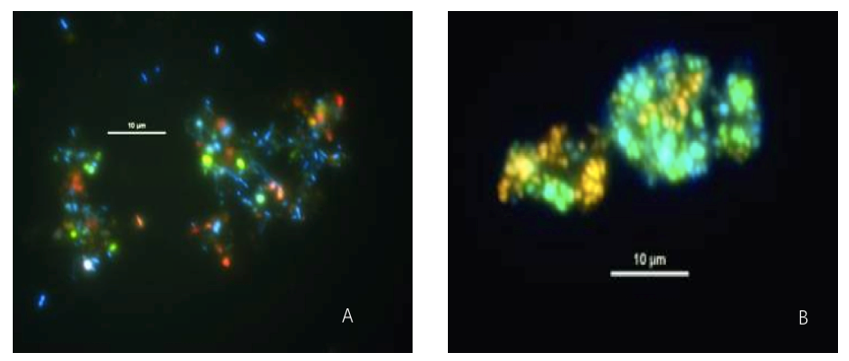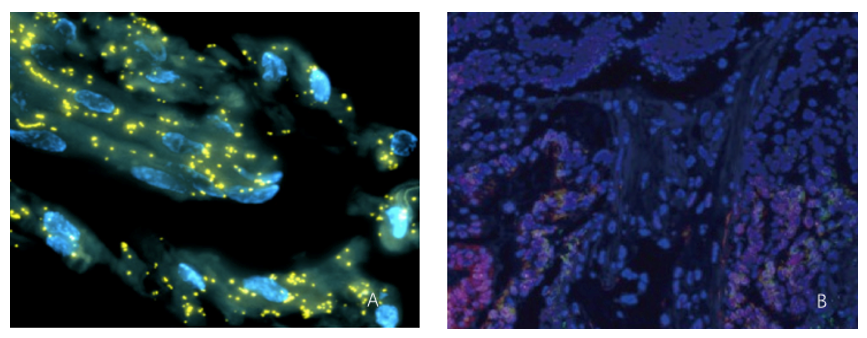FISH Analysis of Microorganisms
Molecular techniques are increasingly being used to identify microorganisms and have revealed polymicrobial processes and numerous species. Fluorescence in situ hybridization (FISH) is a molecular technique that can be used to detect, identify and enumerate specific groups of bacteria and archaea microbes in situ. The technique allows for the direct quantification of specific types of microorganisms without the need to culture the cells in growth media.
Creative Bioarray is one of the well-recognized experts who is professional in FISH technologies for a broad range of project objective. With years of experience, our scientists can offer high-quality FISH analysis of microorganisms to meet your demands.
 Figure1. Methanolobus spp. (orange) and other members of Archaea(green) in CIB-1; Dawson, Katherine S., et al. "Quantitative fluorescence in situ hybridization analysis of microbial consortia from a biogenic gas field in Alaska's Cook Inlet Basin." Applied and environmental microbiology 78.10 (2012): 3599-3605.
Figure1. Methanolobus spp. (orange) and other members of Archaea(green) in CIB-1; Dawson, Katherine S., et al. "Quantitative fluorescence in situ hybridization analysis of microbial consortia from a biogenic gas field in Alaska's Cook Inlet Basin." Applied and environmental microbiology 78.10 (2012): 3599-3605.
 Figure 2. A: FISH detection of Wolbachia (Yellow) on FFPE sections of testes of insects; CRC specimen triply stained with DAPI, EUSO and EUB338. Cell nuclei (in blue), bacterial conserved regions (in green) and F. nucleatum specific regions (in red)
Figure 2. A: FISH detection of Wolbachia (Yellow) on FFPE sections of testes of insects; CRC specimen triply stained with DAPI, EUSO and EUB338. Cell nuclei (in blue), bacterial conserved regions (in green) and F. nucleatum specific regions (in red)
Application:
Detect, identify and enumerate specific groups of bacteria and archaea microbes in situ.
Features:
- High accuracy and sensitivity
- Fast turnaround time
- Competitive pricing
Creative Bioarray offers FISH analysis of microorganisms for your scientific research as follows:
- Probe design
- Probe synthesis
- FISH on samples
- Imaging
- Data analysis
Quotation and ordering
Our customer service representatives are available 24hr a day! We thank you for choosing Creative Bioarray at your preferred FISH Analysis of Microorganisms Service.
References
- Bay L, Kragh K N, Eickhardt S R, et al. Bacterial aggregates establish at the edges of acute epidermal wounds[J]. Advances in wound care, 2018, 7(4): 105-113.
- Schmiedel, D., et al. "Fluorescence in situ hybridization for identification of microorganisms in acute chorioamnionitis." Clinical Microbiology and Infection 20.9 (2014): O538-O541.
- Amann, Rudolf, and Bernhard M. Fuchs. "Single-cell identification in microbial communities by improved fluorescence in situ hybridization techniques." Nature Reviews Microbiology 6.5 (2008): 339.
- Bottari, Benedetta, et al. "Application of FISH technology for microbiological analysis: current state and prospects." Applied Microbiology and Biotechnology 73.3 (2006): 485-494.
- Kostic, Aleksandar D., et al. "Genomic analysis identifies association of Fusobacterium with colorectal carcinoma." Genome research 22.2 (2012): 292-298.
Explore Other Options
For research use only. Not for any other purpose.
Services
-
Cell Services
- Cell Line Authentication
- Cell Surface Marker Validation Service
-
Cell Line Testing and Assays
- Drug-Resistant Cell Models
- Cell Viability Assays
- Cell Proliferation Assays
- Cell Migration Assays
- Soft Agar Colony Formation Assay Service
- SRB Assay
- Cell Apoptosis Assays
- Cell Cycle Assays
- Cell Angiogenesis Assays
- DNA/RNA Extraction
- Custom Cell & Tissue Lysate Service
- Cellular Phosphorylation Assays
- Stability Testing
- Sterility Testing
- Endotoxin Detection and Removal
- Phagocytosis Assays
- Cell-Based Screening and Profiling Services
- 3D-Based Services
- Custom Cell Services
- Cell-based LNP Evaluation
-
Stem Cell Research
- iPSC Generation
- iPSC Characterization
-
iPSC Differentiation
- Neural Stem Cells Differentiation Service from iPSC
- Astrocyte Differentiation Service from iPSC
- Retinal Pigment Epithelium (RPE) Differentiation Service from iPSC
- Cardiomyocyte Differentiation Service from iPSC
- T Cell, NK Cell Differentiation Service from iPSC
- Hepatocyte Differentiation Service from iPSC
- Beta Cell Differentiation Service from iPSC
- Brain Organoid Differentiation Service from iPSC
- Cardiac Organoid Differentiation Service from iPSC
- Kidney Organoid Differentiation Service from iPSC
- GABAnergic Neuron Differentiation Service from iPSC
- Undifferentiated iPSC Detection
- iPSC Gene Editing
- iPSC Expanding Service
- MSC Services
- Stem Cell Assay Development and Screening
- Cell Immortalization
-
ISH/FISH Services
- In Situ Hybridization (ISH) and RNAscope Services
- Fluorescent In Situ Hybridization
- FISH Probe Design, Synthesis and Testing Service
-
FISH Applications
- Multicolor FISH (M-FISH) Analysis
- Chromosome Analysis of ES and iPS Cells
- RNA FISH in Plant Service
- Mouse Model and PDX Analysis (FISH)
- Cell Transplantation Analysis (FISH)
- In Situ Detection of CAR-T Cells & Oncolytic Viruses
- CAR-T/CAR-NK Target Assessment Service (ISH)
- ImmunoFISH Analysis (FISH+IHC)
- Splice Variant Analysis (FISH)
- Telomere Length Analysis (Q-FISH)
- Telomere Length Analysis (qPCR assay)
- FISH Analysis of Microorganisms
- Neoplasms FISH Analysis
- CARD-FISH for Environmental Microorganisms (FISH)
- FISH Quality Control Services
- QuantiGene Plex Assay
- Circulating Tumor Cell (CTC) FISH
- mtRNA Analysis (FISH)
- In Situ Detection of Chemokines/Cytokines
- In Situ Detection of Virus
- Transgene Mapping (FISH)
- Transgene Mapping (Locus Amplification & Sequencing)
- Stable Cell Line Genetic Stability Testing
- Genetic Stability Testing (Locus Amplification & Sequencing + ddPCR)
- Clonality Analysis Service (FISH)
- Karyotyping (G-banded) Service
- Animal Chromosome Analysis (G-banded) Service
- I-FISH Service
- Molecular Karyotyping (aCGH)
- Droplet Digital PCR (ddPCR) Service
- Digital ISH Image Quantification and Statistical Analysis
- SCE (Sister Chromatid Exchange) Analysis
- Biosample Services
- Histology Services
- Exosome Research Services
- Drug Metabolism and Pharmacokinetics (DMPK)
-
Safety Evaluation Services
- High-Content Cytotoxicity Screening
- High-Throughput Toxicity Screening
- In Vitro Cardiotoxicity
- In Vitro Genotoxicity
- In Vitro Hepatotoxicity
- In Vitro Neurotoxicity
- In Vitro Nephrotoxicity
- In Vitro Dermal Toxicology
- Ocular Toxicity
- In Vitro Cytotoxicity
- Endocrine Disruption Screening Assay
- In Vivo Toxicity Study